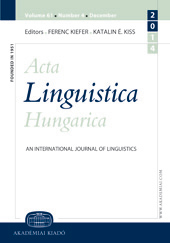Objective conjugation and medialisation
Objective conjugation and medialisation
Author(s): Ferenc HavasSubject(s): Morphology, Finno-Ugrian studies
Published by: Akadémiai Kiadó
Keywords: Hungarian; grammaticalisation; person/number suffixes; typology; medial conjugation;
Summary/Abstract: This paper is concerned with the origins and the function of the objective verbal conjugation especially in Hungarian but with an eye to general typology and Uralic. Previous attempts at solving problems associated with it are given a critical survey. The author argues that since objective conjugation is neither specific to Hungarian nor to its relatives, whether close or distant, but is found in various language families and language types all over the world, one should seek explanations in universal tendencies rather than giving ad hoc accounts. The universal tendency of medialisation is pointed out here-especially in the first and second persons of the paradigm-, which differentiated what is now called the (unmarked) general or indefinite conjugation from the original unitary conjugation. It is here proposed that what now functions as the objective conjugation results historically from a reinterpretation of the original paradigm as in contrast with the medial (then general) paradigm. This explains the curious fact that although the objective paradigm is now seen as the new marked member of the opposition, it is this paradigm that preserves the personal endings going back to the ancestral pronouns. The author also argues that the emergence of an objective conjugation in those Uralic languages that have one represents independent developments, though the preconditions for its evolution may have been there in Proto-Uralic in the form of object syntagms
Journal: Acta Linguistica Hungarica (Since 2017 Acta Linguistica Academica)
- Issue Year: 51/2004
- Issue No: 1-2
- Page Range: 95-141
- Page Count: 47
- Language: English

